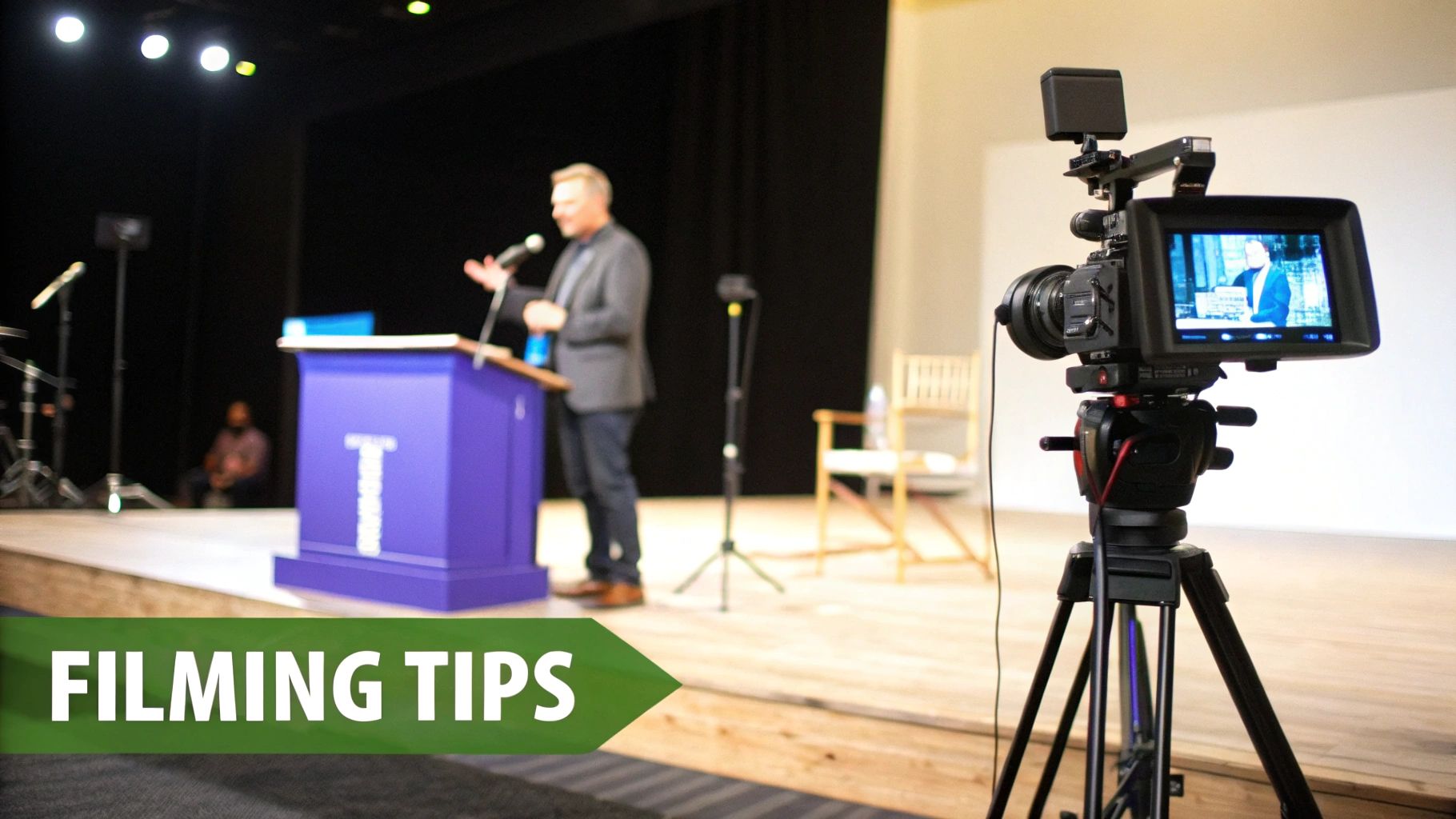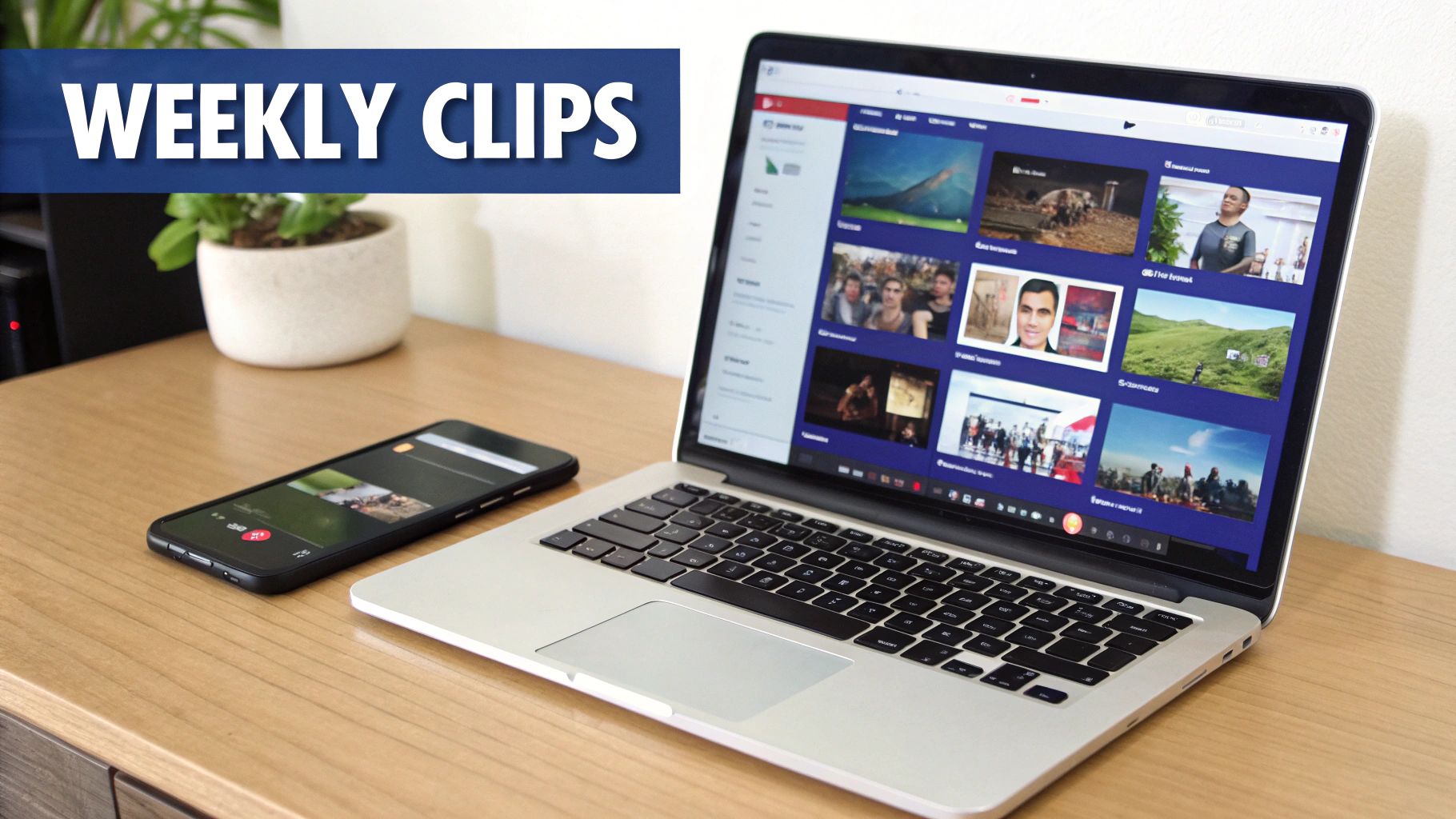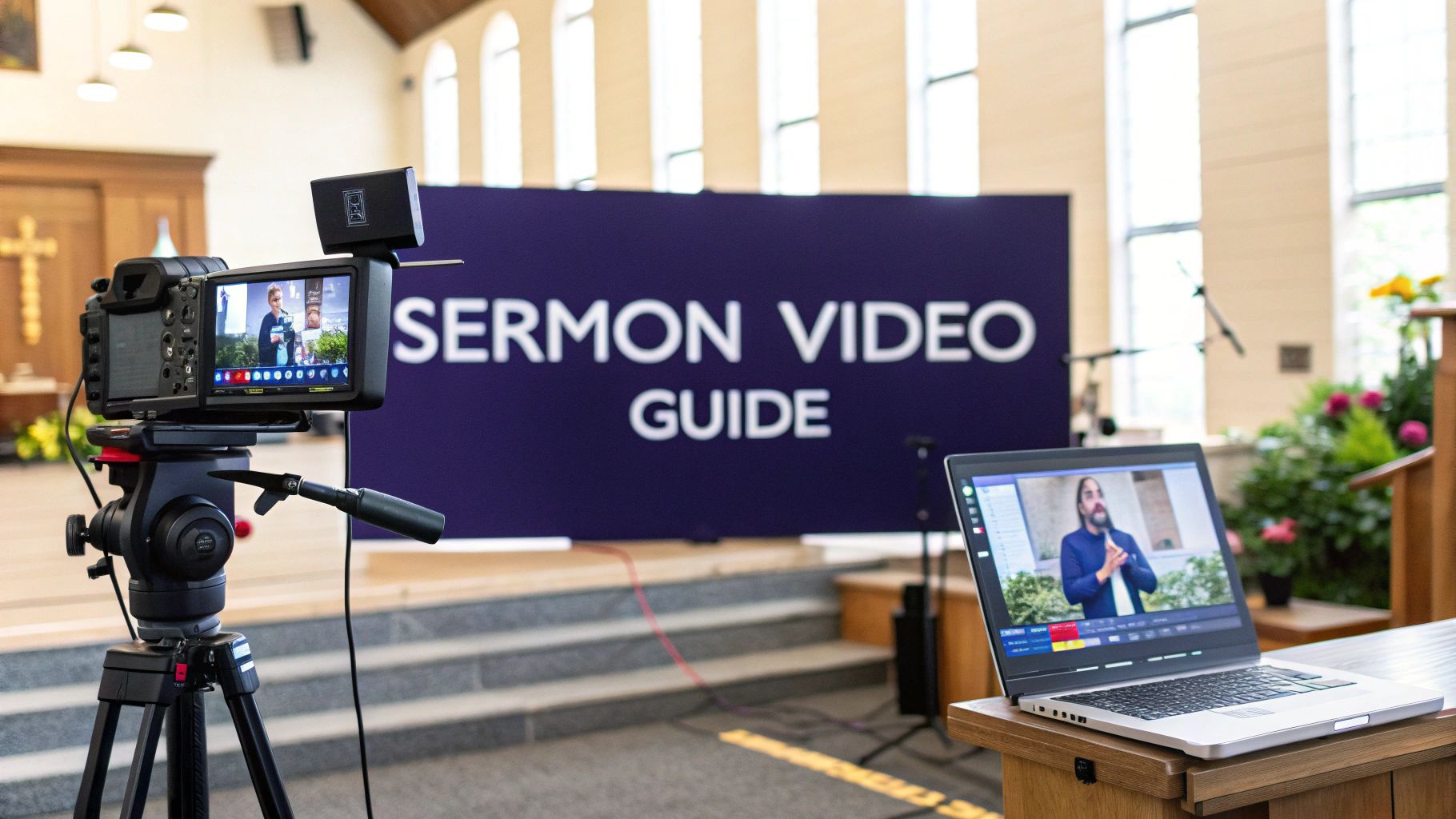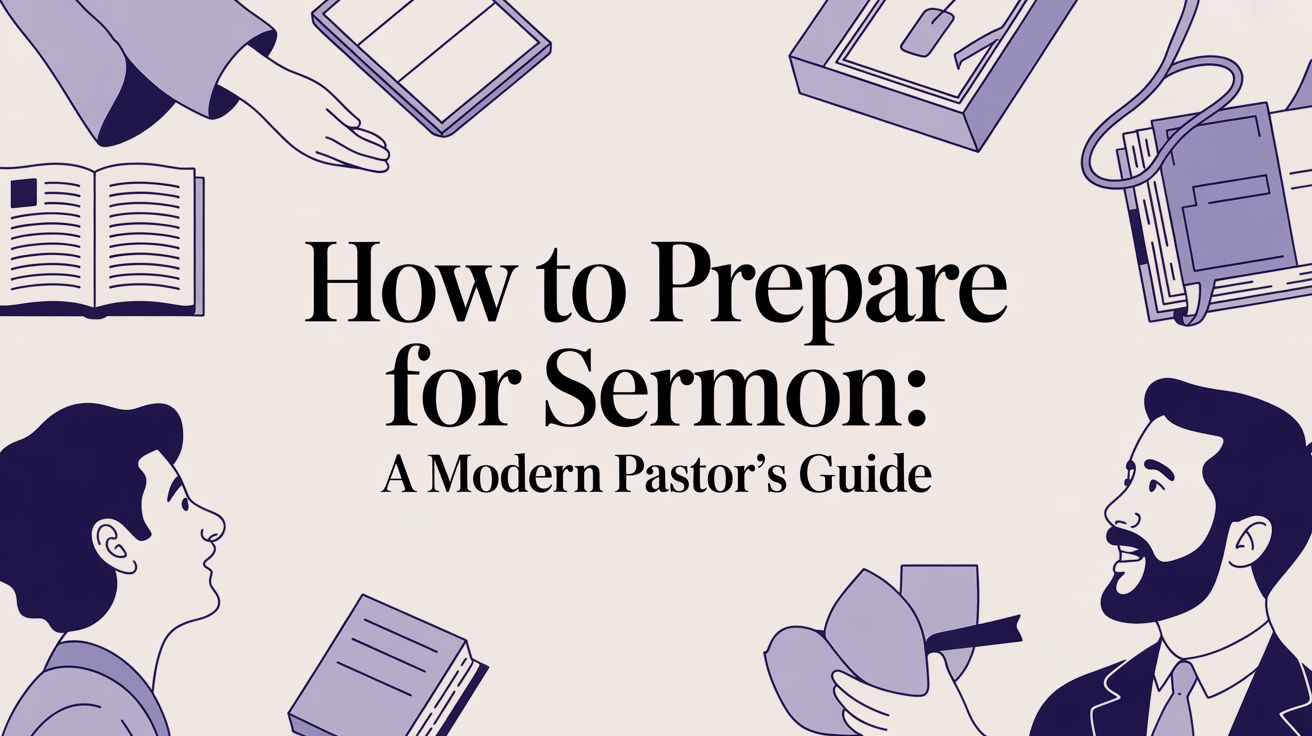Bringing your ministry's message beyond the four walls of the church is no longer just a nice idea—it's essential. And when it comes to reaching people online, nothing connects quite like video. But getting started can feel overwhelming. Don't worry, it boils down to a simple, repeatable process: plan your message, get the right gear, film with intention, and share it where people will see it.
Nailing this down creates a system for producing professional, shareable videos that truly resonate. And with smart tools like ChurchSocial.ai, you can manage your church's entire social media presence, from planning and creation to scheduling, all in one place.
The Blueprint for Modern Sermon Videos
The shift from a Sunday-only ministry to a seven-day-a-week digital presence is here to stay. Video isn't just a pandemic-era trend; it's become a core part of modern outreach. In fact, a staggering 87% of churches plan to keep streaming their worship services in 2025. That number is still near its all-time high, proving just how permanent this digital shift has become.
To make this work long-term, you need a clear, repeatable process. Without a solid blueprint, filming can feel chaotic and the final product inconsistent. A structured approach ensures every recording is high-quality, on-message, and ready to go. And if you ever decide to bring in outside help, understanding your own workflow makes it much easier to partner with professional video and photography services.
A Four-Step Production Workflow
Creating a compelling sermon video doesn't have to be complicated. It really just comes down to four key stages that guide you from the initial idea all the way to getting it in front of your audience.
This infographic breaks down that simple, four-step workflow.

As you can see, it’s a cycle. What you learn from sharing your videos feeds right back into how you plan the next one. This creates a sustainable content engine for your church.
Let's quickly map out what each part of this process involves.
Sermon Video Production At a Glance
Having this framework in place helps keep everything organized and purpose-driven from start to finish.
The goal isn't just to record a service; it's to create an experience that connects with people wherever they are. A clear production blueprint removes the technical barriers, allowing your message to remain the central focus.
This structure also makes your content work harder for you. A well-planned and filmed sermon is incredibly easy to repurpose. For instance, ChurchSocial.ai can take your sermon transcript and automatically generate AI-powered reels, social posts, and even blog content. Suddenly, one sermon becomes a whole week's worth of outreach, all managed through a simple drag-and-drop calendar.
Choosing the Right Gear for Your Church
Investing in video equipment for your sermons can feel a little overwhelming, but you honestly don't need a Hollywood budget to get fantastic results. It really boils down to getting three things right: a solid camera, crystal-clear audio, and good lighting. Nail these three, and you're 90% of the way to a professional-looking video.
It's easy to get bogged down in camera specs, but it's simpler than you think. DSLRs and mirrorless cameras are the sweet spot for most churches—they offer great quality, give you manual control, and let you swap lenses as your skills and needs evolve. You don't need a top-of-the-line cinema camera, but a good mid-range option will deliver a look that a smartphone just can't touch.
For a much deeper dive, we've put together a guide on choosing the best camera for church live streaming to help you sort through the options.

Don't Overlook Audio and Lighting
While the camera gets all the glory, your audio is arguably even more important. Think about it: your audience will forgive a video that isn’t perfectly sharp, but they’ll click away in seconds if the audio is muffled, distant, or echoing. Clear, crisp sound is absolutely non-negotiable.
A dedicated microphone is what makes the difference here. You've got a couple of great choices:
- Wireless Lapel Mic: This clips right onto the speaker's shirt or lapel. It’s perfect for ensuring their voice stays front and center, even if they move around the stage.
- Shotgun Mic: This mic mounts on your camera or a stand and captures directional sound from a bit of a distance. It's a great choice if you prefer to keep the mic out of the shot entirely.
Lighting is that final piece of the puzzle that ties everything together. Bad lighting can make even a great camera produce an amateurish video. A simple three-point lighting setup—a key light, a fill light, and a backlight—is a game-changer. It adds depth, gets rid of harsh shadows, and makes sure your speaker stands out from the background. You can find inexpensive LED panel kits online that are a fantastic starting point for any church.
Remember, the goal is to remove distractions so there’s a clear connection between the pastor and the person watching at home. Good audio and lighting are the unsung heroes that make this happen, allowing the message to shine.
Once your gear is in place and you've captured the footage, the real fun begins. You can take that one sermon and turn it into a whole week's worth of content. Platforms like ChurchSocial.ai can take your sermon transcript and instantly create AI-generated reels and social media posts, extending the life of your message far beyond Sunday morning.
Filming Techniques That Captivate Your Audience
You’ve got the gear. Now comes the fun part: figuring out how to film. The way you handle the camera is what turns a basic recording into a genuine experience for someone watching from their couch. It's not just about pointing the lens at the stage; it’s about intentionally guiding the viewer's focus and forging a connection that feels personal, even through a screen.

This is how your video for sermons avoids feeling cold or distant. A few simple adjustments to your framing, camera angles, and movement can make all the difference in holding an online viewer’s attention. The whole idea is to make them feel like they're right there in the room with you.
Framing Your Speaker with Purpose
How you frame your pastor is the bedrock of a good sermon video. The most reliable and effective shot is the medium shot—basically framing the speaker from the waist up. This is the sweet spot. It's close enough to capture their facial expressions and hand gestures but wide enough to convey their presence on stage.
If you’re working with a single camera, make this your default shot. If you have the luxury of multiple cameras, you can really start to build a more dynamic viewing experience.
- Wide Shot: Set one camera for a wide view showing the entire stage, maybe even the first few rows of the congregation. This shot establishes context and helps the viewer feel like they're part of the gathering.
- Medium Shot: This is your workhorse. Keep your main camera on a steady medium shot of the speaker. You'll cut back to this one the most.
- Close-Up Shot: A third camera can be your "emphasis" shot. Use it for occasional close-ups to highlight a key point or a powerful, reflective moment.
Mixing these shots keeps the video from feeling flat and prevents the viewer’s eyes from glazing over.
The Impact of Camera Angles and Movement
Believe it or not, your camera angle sends a subtle but powerful message. Try to place your camera at or just slightly below the speaker's eye level. This creates a feeling of authority and a direct connection, almost as if they're speaking directly to the person watching. Definitely avoid high angles that look down on the speaker; it can accidentally diminish their presence.
A little bit of camera movement can also add a professional touch. If you've got a fluid-head tripod, a very slow, almost imperceptible pan during a story can draw the viewer in. The key word here is subtle. Any sudden, jerky movements are just a distraction.
The best filming techniques are the ones the audience doesn't even notice. They just feel more connected to the message. Your camera work should always serve the sermon, not distract from it.
Once you have this powerful footage, you can do so much with it. For example, a tool like ChurchSocial.ai makes it incredibly simple to take your well-filmed sermon and turn it into a ton of content. The platform’s AI can automatically create AI-generated reels from your sermons and generate content from the transcript, like social posts and blogs, making sure your message continues to reach people all week long.
Editing Videos to Hold Viewer Attention
Let's be honest: raw footage, no matter how great the service was, usually isn't ready for an online audience. The magic happens in the editing room. This is where you shape the sermon into a story, tighten up the pacing, and make sure your message cuts through the noise for viewers who are always just one click away from a distraction.
Your first job is to trim the fat. A live sermon has a certain rhythm that just doesn't work the same on video. Don't be afraid to be ruthless. Cut out the long pauses, the five-minute announcements, or the awkward transitions between worship and the message. The goal is to create a tight, seamless experience that gets straight to the point while respecting the viewer's time.
Enhancing Clarity and Impact
Once you've got a clean cut of the sermon, it's time to add some polish that boosts comprehension and gives it a professional feel. A few simple additions here can make a world of difference.
- Lower-Thirds: These are the simple graphics at the bottom of the screen. Use them to show the speaker's name and title, the sermon series, or key scripture references as they come up. It's an easy way to provide context without being distracting.
- Integrated Slides: If your pastor uses slides, edit them directly into the video. Showing a crisp, full-screen graphic of a key point is so much more effective than pointing a camera at a washed-out projector screen.
- Audio Mixing: This is non-negotiable. You have to clean up the audio. Balance the levels so the voice is clear and consistent, and do your best to remove distracting background noises like coughs, sniffles, or mic feedback. Crystal-clear sound is everything.
A well-edited video does more than just show what happened on Sunday; it guides the viewer's experience. By adding graphics and cleaning up the audio, you're removing obstacles and making it easier for the message to land.
Streamlining Your Editing Workflow
Editing can quickly become a massive time-sink, especially for busy church staff and volunteers. Finding an efficient process is absolutely essential. This is where having an all-in-one platform can be a lifesaver. If you're weighing your options, our guide on the best video editing software for beginners is a great place to start.
This is precisely the problem a tool like ChurchSocial.ai was built to solve. Instead of bouncing between three or four different programs, everything you need is right there. You can use our graphic templates and editor to create and post photos and carousels, and our simple drag-and-drop calendar allows churches to easily manage and update all of their social media.
Even better, ChurchSocial.ai uses AI to automatically pull short, shareable clips and reels straight from your sermon transcript. Think about that: from one edited sermon, you can generate a whole week's worth of engaging social media content in just a few minutes. It completely changes your workflow, freeing you up to focus on actual ministry instead of getting bogged down in tedious editing tasks.
Turning One Sermon into a Week of Content
You've poured a ton of time and energy into filming and editing a powerful sermon video. Great. But the real magic happens when you make that one piece of content work for you all week long. Let's move past the "one and done" approach.
Instead, you can strategically chop up and repurpose your sermon to create a steady drip of engaging material for all your social media channels. This is how you shift from being a content creator to a content multiplier. Just imagine taking that one hour-long sermon and effortlessly spinning it into five to seven unique posts. It’s how savvy churches are blowing up their online engagement without burning out their staff or volunteers.
Automate Your Content Creation
Look, the key to making this work is efficiency. Manually scrubbing through footage to find good clips, writing captions, and then trying to design graphics is a massive time-suck. This is exactly where an intelligent platform can change the game. With a tool like ChurchSocial.ai, the whole process gets a lot simpler.
The platform's AI scans your sermon transcript and automatically pinpoints the most powerful, shareable moments. It then kicks out ready-to-post, AI-generated reels and short video clips—captions and all—perfect for Instagram and TikTok.
Here’s a peek at the ChurchSocial.ai dashboard, which pulls your content calendar and AI tools into one spot.
As you can see, having everything from scheduling to creation centralized makes managing your church's social media incredibly straightforward.
The goal isn't just to post more often; it's to share the most powerful, bite-sized moments from your sermon in formats people love to consume and share.
With ChurchSocial.ai, you can also use our graphic templates and editor to create and post photos and carousels. The AI can even generate content from the sermon transcript like social posts and blogs. Our simple drag-and-drop calendar allows churches to easily manage and update all of their social media. We dive deeper into this in our article covering the best content repurposing tools for churches.
The results from this strategy speak for themselves. Studies show that video content is 1200% more likely to be shared on social media than text and images combined. This makes repurposing your sermon video an incredibly powerful way to grow organically. By turning one sermon into a full week of content, you amplify its reach and impact far beyond Sunday morning.
Distributing Your Videos for Maximum Reach
You’ve poured your heart into filming and editing a powerful sermon video. That’s a huge accomplishment. But if no one sees it, the message gets lost. The final, crucial piece of the puzzle is getting that video in front of your community and reaching new people. This isn't just about uploading it to one place and calling it a day; it's about building a smart, multi-channel strategy that connects with people right where they are.
Your church website should be ground zero for all your video content. Think of it as your digital home base. Embedding the full sermon there is a fantastic way to serve your congregation, but it also gives your site a nice SEO boost, making it easier for people searching online to discover your church. After that, hit their inbox. A direct link to the sermon in your weekly newsletter is a personal touch that keeps members who might have missed the service connected and engaged.
Bridging the Digital and Physical Gap
Let's be honest, the way people "do church" has shifted dramatically. While more and more churches are embracing video for sermons, the old patterns of in-person attendance are changing. Did you know that weekly church attendance among adults in the United States has fallen to just 20%? That’s a steep drop from the nearly 50% who attended regularly in their youth.
Video becomes a vital bridge here. It’s how you can reconnect with those who, for whatever reason, have drifted from traditional services. You’re literally meeting them where they are. To make sure your sermon videos are as effective as possible, you really need to get a handle on the major online platforms. A great starting point is learning about optimizing distribution and maximizing reach on platforms like YouTube.
Automate Your Outreach with Smart Tools
Trying to manually post and share your content across every channel is a recipe for burnout. This is where having an integrated system can be a total game-changer. For instance, a tool like ChurchSocial.ai can connect directly with Planning Center or whatever calendar system you use.
This integration automatically creates promotional content for upcoming events, sermons, and gatherings. It transforms your calendar from a simple schedule into a dynamic content engine, ensuring your community is always informed and engaged.
Imagine planning out your next sermon series and having ChurchSocial.ai automatically generate and schedule the promotional posts for you. It closes that gap between planning your message, creating the video, and actually getting it out there. This frees you up from the manual busywork and ensures your powerful message reaches as many people as possible.
A Few Common Questions
Jumping into the world of sermon videos always brings up a few questions. Let's tackle some of the most common ones we hear from churches just like yours.
What's the Best Way to Pull Shareable Clips from a Full Sermon?
Honestly, the most efficient way these days is with a smart AI tool. Something like ChurchSocial.ai can scan your entire sermon transcript, pinpoint the most powerful moments, and then automatically create AI-generated reels from your sermons. It's a massive time-saver compared to scrubbing through footage manually.
What's the Absolute Minimum Gear I Need to Get Started?
You can get a really solid setup without breaking the bank. A great starting point includes a reliable mirrorless or DSLR camera with a flexible lens (a 24-70mm is a fantastic all-rounder), a separate microphone for crisp audio, and a basic three-point LED lighting kit. Those three pieces are the bedrock of good video.
How Can I Make Our Videos Look More Pro Without a Big Budget?
It all comes down to mastering the fundamentals. They make the biggest difference.
- Go for Stable Shots: A tripod is non-negotiable. It instantly gets rid of that distracting shaky-cam look.
- Prioritize Clear Audio: Your microphone is often more important than your camera. Bad audio will make people click away faster than anything.
- Get Your Lighting Right: Even a simple, affordable lighting kit can make your video look ten times more polished.
How Do We Actually Get People to Watch the Sermons?
You have to be intentional about getting the word out. Start by thinking like a search engine—use titles and descriptions with keywords people might actually look for. Then, share those clips across all your social media channels, make sure the full video is embedded on your church website, and definitely send a link out in your email newsletter. The goal is to meet your congregation where they already are.
Ready to turn one sermon into a whole week's worth of content without adding hours to your plate? ChurchSocial.ai uses AI to whip up reels, social posts, and graphics from your message in just a few minutes. Plan, create, and schedule your church's social media with ChurchSocial.ai.




